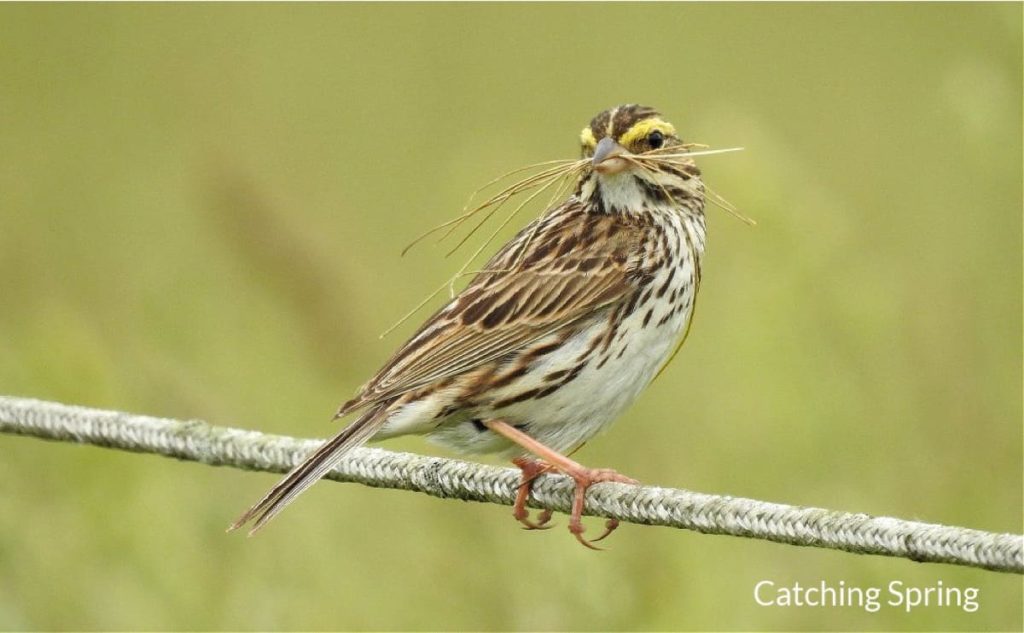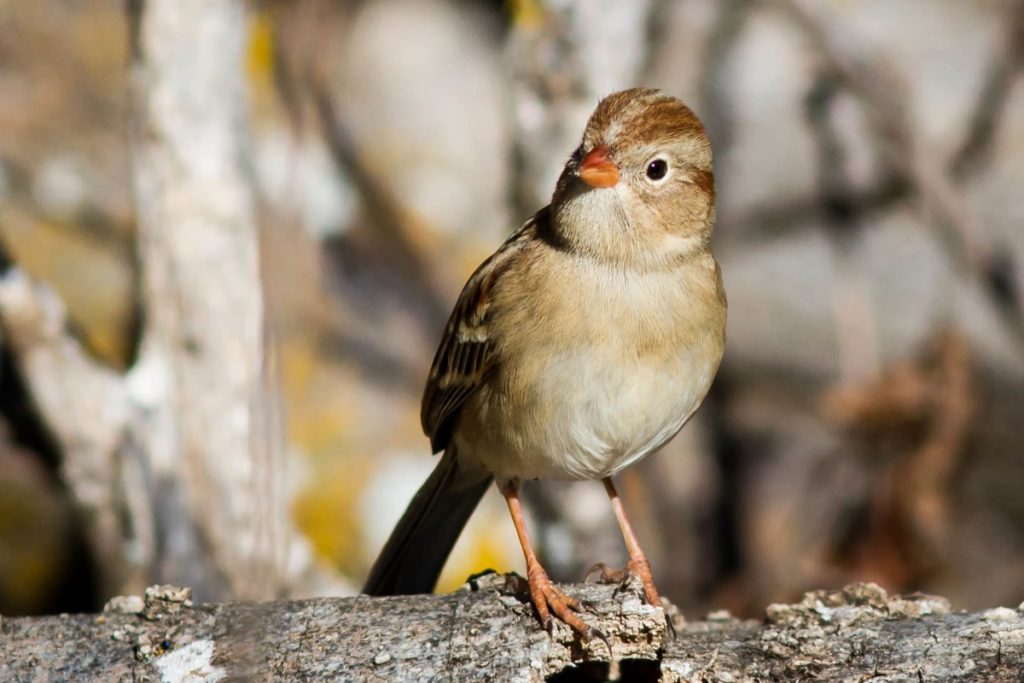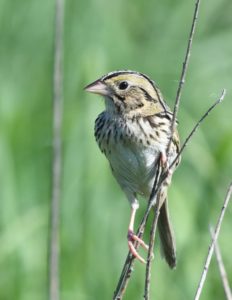When some of us think of sparrows, we think of a small brown, dull bird that might even be invasive. This is the wrong image of native sparrows! Explore these 15 beautiful, endearing birds and learn why they are not only important but a bird you want in your yard!
Native Sparrows – Get To Know These 15 Beautiful Birds
What makes a sparrow native?
First, I want to explain just what makes a sparrow native. This is mainly because when most people, especially non-birders, hear “sparrow,” they think of the common House Sparrow. This is an Old World sparrow not from the United States but was brought here in 1851 to the Bronx, New York, to be exact.
As with many species of animals, vegetation, and fungus not native to the USA, they tend to be invasive and “take over.” Unfortunately, the House Sparrow, which is native to parts of Asia, North Africa, and most of Europe, is no exception.
They are highly aggressive little birds who will kill a native swallow, bluebird, wren, or anything else in a nest box to take over and nest in it themselves. It’s essential to monitor your nest boxes if you have any for native birds!
Many don’t understand the beauty and importance of native sparrows, not to mention their beautiful bird song. So I hope you enjoy learning about the 15 native sparrows in this article!
1. White-throated sparrow

I have a special place in my heart for these little birds! The white-crowned sparrow has this beautiful, almost-melancholy song that I hear in the spring and fall when they pass through my area to nest north.
They have this beautiful, mask-like white, black, and yellow color on their face, and they tend to stick to the ground to eat or hide in bushes, trees, or thickets. These little birds will even sing in the winter; they are pretty endearing.
They’ll readily come to your yard for seed, especially black-oil sunflowers. I have only seen them on the ground here, not actually on a feeder.
You may see them in flocks or alone, but you will almost always hear them first with that beautiful song! Love!
2. White-crowned sparrow

These native sparrows are a pure joy to have around, and like the white-throated, I usually see them in the spring (and sometimes fall) when they pass through.
You’ll always know they are around by their adorable, spunky little call, which does seem to vary. They also will readily come to your yard and eat under the feeders.
They will almost always bathe in my birdbath here and don’t seem very afraid of my presence as I take pictures of them through my window.
They also like thickets and edges of forests like the white-throated, and most often are found near the ground. They tend to winter in the mountains or along the coast.
Watching them scratch back and forth on the ground for seed is endearing, and the crown of black and white markings on their head is a stunning mark of this sparrow. One of my favorites!
3. Savannah sparrow

The Savannah sparrow is a grassland bird found nesting in hayfields, grassland habitat, and pretty much any low-vegetation area.
You won’t attract these native sparrows with birdseed, but if you have a nearby field, you just may see them in the summer months (at least for us Midwesterners!).
They nest yearly in our hayfields, and listening to them singing away on a fence post is always a happy sound. They have this little yellow eyebrow and a spunky, cheerful personality. I do love this sparrow!
I have to note that I won’t allow our hay to be cut until after the Savannah sparrows, Bobolinks, and other grassland birds are done nesting. This is a beautiful option anyone can take to help save our grassland birds and habitat!
4. Chipping sparrow

Most of us are familiar with the small, happy little chipping sparrow. All we need to do is hear the long trill of their song in spring and know they are here for the season.
These native sparrows are more readily seen in yards, parks, and more “people occupied” areas. They welcome the feed that falls under your feeders and may even nest nearby in a low bush, pine tree, or grapevine.
They really do seem to be cheerful little birds. Although just barely bigger than a chickadee, their personality makes up for it. Recognize them not only by their song but the chestnut-colored cap on the top of their heads. I love these little guys! Basically, I love all of the native sparrows! 🙂
5. Fox sparrow

These shy native sparrows tend to stay close to cover but may be seen scrounging around under your feeders. And if you watch the ground for them, especially near bushes or thick scrub, you just may see this stunning bird.
Aptly named, they have a beautiful rust color to them, along with rust-colored splotches and stripes on their bodies. They have a mixture of rust and gray on their head and have a beautiful song that might alert you of them being near.
I usually only see them in the spring or fall here, and not very often. They breed in coniferous forests or dense mountain scrubs and will winter near forests or thicket-like habitats.
6. Song sparrow

Song sparrows are the harbingers of spring in the sparrow world! They are the first of the native sparrows I usually see here in the Midwest, and it’s always such a welcoming sound! I simply love their happy little songs and hear them often in my fields and at the edges of the woods.
They will also frequent yards, mostly staying in low branches or thick, overgrown fields and meadows. You can find this happy bird in nearly every open habitat, including grasslands, edges of marshes, forest edges, and backyards.
They are pretty birds with deep streaking, which varies extensively depending on their area. Some even seem to have a spot on their chest, which will almost always throw me off at first! They have beautiful markings on their head as well. Love these readily-singing little birds!
7. Field sparrow

It literally took me years to finally identify this small, “plain” native sparrow. If you live anywhere near fields, grasslands, hayfields, or meadows, you are sure to hear them. Visit almost any nature center with various habitats, and hear them there as well.
I first took pictures of these native sparrows where farm fields and woods meet but thought maybe it was a juvenile of some sort. Then, every spring, I would hear this long whistle-turned-trill and wonder who that beautiful song belonged to.
Finally figured it out when I saw one sing, field sparrow! These warm-colored birds have a distinctive white eye-ring, a warm-brown cap, and mostly gray face, which is also the color of their bellies. They have soft sparrow-like browns on their back and tend to stay covered in shrubs or edges of fields and trees.
You mostly know they are there by the beautiful song of the male. They may be found in your yard and maybe even around your feeders, but mostly they’ll be near cover. These little guys deserve to be appreciated. 🙂
8. American Tree Sparrow

Looking like a Chipping sparrow at first glance, you’ll notice that they often have a dark spot right on the center of their chest. Sometimes it’s more of a smudge, while others, it is pretty dramatic. They have a pretty, rust-colored brown hat and pretty song.
I only see them during the fall or winter here, and they are usually seen on or near my feeders. These stout little native sparrows will often fluff up their feathers, making them look like round little chunkies. 🙂
They prefer weedy fields with shrubs, edges of forests, or near marshes. They are rarely seen south of northern Canada in the summer as that’s where they breed! Always fun to see these native sparrows in the winter!
9. Swamp sparrow

The swamp sparrow is a compact little bird with a long tail, and if you can catch sight of one, you’ll appreciate the beautiful markings and colors on their head.
Often hidden in shadowy habitats, they forage near the ground or water surfaces. Their long legs enable them to wade around in the muddy areas in search of food.
These cute little native sparrows are almost always seen near water, marshes, or wet fields – even during migration. I love their bubbly, trill-like little song, and if you find them in the proper lighting, they almost look like they have a light behind their gray breasts.
10. Junco

Yes, the Junco is actually a sparrow! These adorable, chunky little birds will grace most of our yards in the Midwest once winter is on its way. They prefer the cooler weather and will migrate north once spring starts moving in.
You can find these charming little birds scooting back and forth under your feeders, happily eating the seed that falls to the ground. They are noticeable with their dark backs and white bellies, and once spring hits, they can be heard singing their song that resembles a chipping sparrow.
My grandma, who helped my love of birds, always called these “snowbirds.” Love the Juncos!
11. Five more native sparrows
I had to mention the following five native sparrows, although they aren’t quite as common. They are just as important and beautiful, though!
1. Grasshopper sparrow
The grasshopper sparrow literally sounds like a grasshopper, and it’s almost always concealed in grasses or low vegetation. Males can be seen singing on wires or tall vegetation, and if you can see them close enough, you’ll notice the yellow markings on the face and their distinct, compact shape. They will often walk or run through the grass instead of fly! Although they aren’t quite as popular in my area, they are sure appreciated and beautiful!
2. Vesper sparrow
The beautiful streaking of the Vesper sparrow may have you thinking you found a juvenile bird of some kind. Their streaking is distinct and pretty, and their lovely song can be heard from wherever they perch to sing it. They aren’t quite as elusive as some of the others and often can be seen with Savannah and Grasshopper sparrows and others. They like open grassy areas and tend to avoid taller grasses and marshes.
3. Lincoln’s sparrow
This is another native sparrow with beautiful striped markings mixed with rusty browns, grays, buffs, and black. You may hear this bird before seeing it, as they are pretty secretive, preferring to stay in the brush near the ground. They tend to breed near shrubby areas near streams or damp meadows. They also love trees like willows, aspens, and cottonwoods – sweet, dainty little birds.
4. Henslow’s sparrow
The sweet little Henslow’s sparrow has pretty yellow/olive wash on his face, which helps them stand out among their other striped relatives. Their wings are also rusty-tipped, and their body streaks are shorter, complimented by their off-white belly. I really love the look of these native sparrows, including the stripes on their head, but you may only hear their short songs as they are highly elusive. Preferring to forage and hide out among the grasses and weeds, they would rather walk/run than fly. They breed in weedy or wet pastures, fields, or meadows.
5. LeConte’s sparrow
This is a beautiful little bird with its orange-buff color, complemented with black streaks and a white belly. This is another secretive sparrow who would rather walk or hop on the ground instead of fly. Sounding more like an insect instead of a bird, you may not even realize these native sparrows are near. They breed in open habitat with dense cover and love marshes and wet areas.
There are, of course, many more native sparrows I could happily add to this list! These would include not only the ones that live in the eastern or Midwest part of the United States, like the Clay-colored sparrow, but those that live in the west. Then, you have birds closely related to the native sparrows, and the list could go on!
I DO hope you enjoyed this article on our native sparrows and have fun looking for them next time you go birding or walking.
Always remember to move slowly, NEVER try to chase or flush them out, and please please please respect their space, especially if they are nesting. Also, please NEVER use bird calls to entice them out. This could actually result in birds abandoning babies in nests. THANK YOU!
What other native sparrows could you add to this list? Please comment below, would love to talk birds! 🙂





Leave a Reply